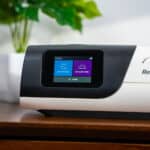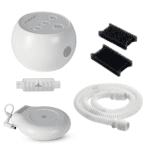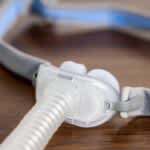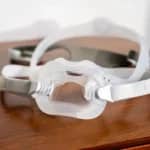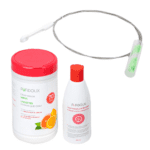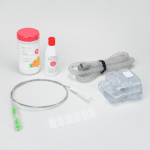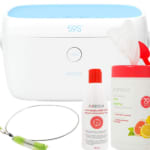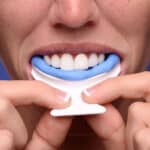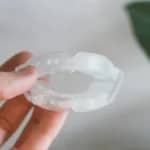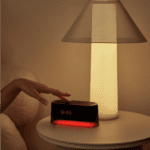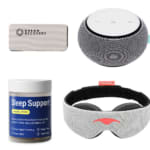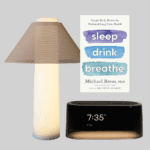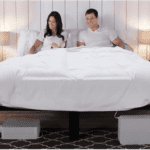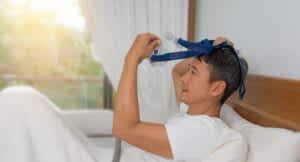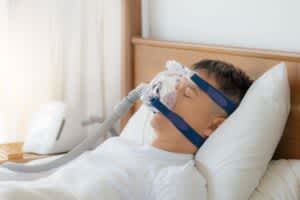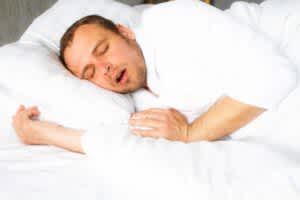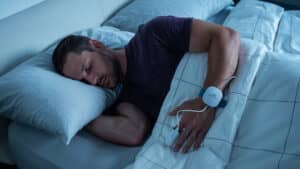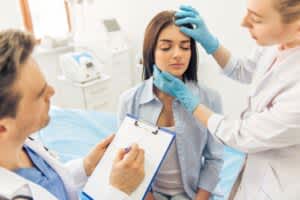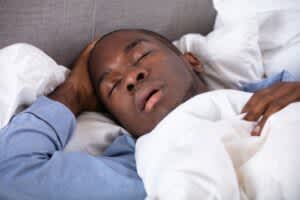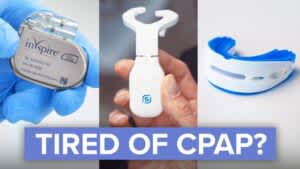Medical Disclaimer: The following content should not be used as medical advice or as a recommendation for any specific supplement or medication. It is important to consult your health care provider prior to starting a new medication or altering your current dosage.
Nearly 30 million people in the U.S. live with obstructive sleep apnea (OSA), a sleep-related breathing disorder that can cause snoring, nighttime wakings, and poor-quality sleep. Finding the right treatment can alleviate many of the symptoms of OSA and reduce the risk of other health problems as well.
OSA can be diagnosed with a simple home sleep apnea test. The preferred treatment for OSA is continuous positive airway pressure (CPAP) therapy, which requires a person to wear a mask attached to a machine that helps regulate breathing. However, due to discomfort from equipment and other factors, many people find it hard to use CPAP machines on a regular basis.
Oral appliances have increasingly become a popular treatment option for OSA. Usually customized to fit an individual’s mouth, oral appliances reposition the jaw or tongue so that a person can breathe without obstruction. They can also be used to treat snoring.
For people with mild to moderate OSA, oral appliance therapy can be an effective treatment. But there are different types of oral appliances, each with unique features. Learn more about these types of appliances, how oral appliances work, and how they differ from other sleep apnea treatments.
How Oral Appliance Therapy Treats Sleep Apnea
Obstructive sleep apnea occurs when the muscles around the upper airway relax and tissues in the throat or mouth collapse, blocking air flow. Oral appliances treat OSA by holding the mouth in a position that keeps the upper airway open while a person sleeps.
While CPAP therapy uses pressurized air flow regulated by a machine to maintain an open airway during sleep, oral appliances reposition the jaw, tongue, or both to prevent obstruction of the airway without the use of a machine or other equipment.
According to sleep experts, this treatment option is appropriate for people with mild to moderate OSA who are unable to tolerate CPAP therapy.
Snoring? An At-Home Sleep Test May Be the Answer

Save 54% on your Sleep Test Today
Simple and convenient
- Equipment delivered to your doorstep
- One overnight test in the comfort of your own bed
Uncover sleep apnea
- Quietly collects data while you sleep
- 98% effective in detecting sleep apnea
Affordable & ships fast
- In-lab sleep tests cost ~$3,000+ (this one’s $189), HSA/FSA eligible
- Arrives in 2-4 business days
Types of Oral Appliances for Sleep Apnea
There are two main types of oral appliances for treating sleep apnea: mandibular advancement devices and tongue-retaining devices. Other devices are available, but they are still undergoing research and are not as widely used.
Personal preference can have a major role in determining which device may be right for you. Likewise, your mood, lifestyle, and social support can impact your decision to use oral appliances or another treatment option.
Mandibular Advancement Device
Mandibular advancement devices (MADs), also called mandibular repositioning mouthpieces or mandibular advancement splints, can reduce the severity of obstructive sleep apnea. These are the oral appliances that are most commonly used for treating OSA.
Mandibular advancement devices fit around the upper and lower teeth and are worn only while sleeping. They enlarge the airway by pulling the lower jaw forward, preventing the tongue and other tissue from relaxing into the throat.
When worn regularly, a MAD may cause a progressive repositioning of the lower jaw and gradually relieve symptoms of OSA.
Experts recommend using custom-made mandibular advancement devices for treating OSA. A health care provider creates custom-made MADs by having a person bite into a dental cast. Regular follow-up visits are usually necessary to make adjustments to the device, both for comfort and to monitor the position of the jaw.
Some characteristics can make certain people better candidates for mandibular advancement devices. Studies suggest that young female users with mild to moderate OSA, low body mass, and a small neck circumference are more likely to find success with a MAD.
Tongue-Retaining Device
Tongue-retaining devices (TRDs), also called tongue-stabilizing devices, use suction to pull the tongue and hold it out of the mouth during sleep. The suction and positioning prevents the tongue from blocking the airway.
While studies of these devices are limited, TRDs are generally considered effective at improving sleep apnea. One study found that tongue-retaining devices can reduce breathing disruptions during sleep by 53%. People who use these devices also report improved quality of life and less daytime sleepiness.
Tongue-retaining devices can be alternatives to mandibular advancement devices, especially for people who cannot use MADs. They are more accessible and can be purchased without a prescription. But people are less likely to regularly use TRDs than MADs, mainly due to discomfort from the suction action and difficulty keeping the device in place.
Tongue Muscle Stimulation Device
One of the newest types of oral appliances for treating obstructive sleep apnea, this device delivers mild electric pulses to the tongue, stimulating the muscles and improving muscle tone. Over time, muscles grow stronger, supporting the tongue and preventing it from falling back into the airway during sleep.
Instead of being worn throughout the night like other oral appliances, a tongue muscle stimulation device is used during the day for a short period of time. For the first six weeks of treatment, a person wears the device for 20 minutes per day. Thereafter, they should use the device for a 20 minute session once per week.
Currently, doctors may prescribe tongue muscle stimulation devices to people with mild OSA and people who snore. Early research shows that the devices can reduce breathing disruptions by 48%. Researchers continue to investigate whether stimulation devices are a safe and effective treatment option for people with other types of sleep apnea.
Oral Appliances Compared to Other Sleep Apnea Treatments
The benefits of oral appliances have mainly been compared to the benefits of CPAP therapy, the most common treatment for obstructive sleep apnea. Other treatment options like surgery are generally only appropriate for people who have not been able to tolerate or benefit from positive airway pressure (PAP) therapy or an oral appliance.
Both CPAP therapy and MADs improve the symptoms of OSA, with most users reporting less daytime sleepiness and lower blood pressure. However, CPAP therapy is better at lowering the rate of disrupted breathing events per hour, an important measurement for determining the severity of a person’s sleep apnea.
Nearly half of people who use CPAP machines find it difficult to follow the guidelines necessary for effective treatment. Many people find the equipment to be uncomfortable and the noise to be disruptive. This can lead them to stop CPAP after only a few hours or not use it at all on some nights, making treatment less successful.
Because sleep apnea is a chronic condition, using a treatment consistently is key to the treatment’s effectiveness. Several studies have reported that people are more likely to use oral appliances on a regular basis, making them an appropriate alternative treatment for mild or moderate obstructive sleep apnea when CPAP therapy doesn’t work.
Risks of Oral Appliance Therapy
Oral appliance therapy can have both short-term and long-term side effects. In most cases, side effects from OSA are temporary and go away within a few weeks after regular use and properly fitting the appliance.
People undergoing oral appliance therapy commonly report mild side effects, including:
- Dry mouth
- Increased saliva
- Discomfort in the teeth
- Tender muscles
- Jaw pain
- Irritated gums
- Shifting of teeth
Sometimes the side effects of oral appliances can be more severe and become progressively uncomfortable, causing some people to stop treatment.
Long-term side effects of treatment with oral appliances can include changes in a person’s overbite or the repositioning of their upper teeth. Some of these skeletal and dental changes can be permanent. However, most people don’t notice dental changes, and many report that the benefits of oral appliance therapy outweigh the side effects.
Talk to Your Doctor About Oral Appliances for Sleep Apnea
About 80% of people with sleep apnea are undiagnosed. If you struggle to fall asleep at night or experience excessive daytime sleepiness, reach out to a health care provider to get the proper diagnosis and treatment recommendations.
It’s very important to get treatment if you have obstructive sleep apnea. OSA can affect your health, resulting in disrupted sleep, daytime sleepiness, and increased blood pressure. It can also impair your mental functioning and increase your risk of workplace accidents and car crashes.
If you have been diagnosed with mild to moderate obstructive sleep apnea and struggle with using CPAP, consider asking your doctor about alternative treatment options such as oral appliance therapy. Your doctor can assess what treatment options are best for your lifestyle and needs.
Frequently Asked Questions About Oral Appliances for Sleep Apnea
Some oral appliances for treating mild to moderate obstructive sleep apnea and snoring are available over the counter. People may choose pre-manufactured plastic mandibular advancement devices, which can fit to the teeth by warming the material and biting down. Tongue-retaining devices can be purchased through online retailers.
However, experts recommend getting a custom-made oral appliance for treating OSA, as it will generally be more effective and more comfortable. Customized devices require working with a health care team, often including a dentist, to ensure proper fit and follow-up care. Some oral appliances may be covered by a person’s health insurance.
Custom-made adjustable mandibular advancement devices are generally considered the best oral appliances for treating OSA. They are also the most commonly recommended oral devices, with ample evidence to suggest that they may be more effective than other devices at improving OSA symptoms.
People tend to tolerate MADs better than tongue-retaining devices. However, tongue-retaining devices may be a better option for people who do not have enough teeth to support a MAD, or for those who have other dental or skeletal complications.
Newer treatments like tongue nerve stimulation devices may be used for mild obstructive sleep apnea, but more research is needed to know whether they can be effective for more severe cases.
At this time, oral appliances are not intended to treat people with central sleep apnea.
Oral appliances show a great deal of promise as an effective treatment for people with mild or moderate cases of obstructive sleep apnea. Specifically, custom-fit mandibular advancement devices can reduce snoring and the number of breathing disruptions a person has per night, an important signifier of effectively managed OSA. They are also considered easy to use.
People who use MADs report less daytime sleepiness and improved cognitive function and quality of life. Additionally, MAD therapy can also have long term positive effects on a person’s heart health, lowering blood pressure and reducing the risk of heart-related events.
References
The Sleep Doctor Forum: Real Experiences, Real Connections
Continue the discussion on the Sleep Doctor Forum. Connect with experts and fellow forum members on CPAP, sleep apnea, and all things sleep. A priceless resource that’s free to join.

